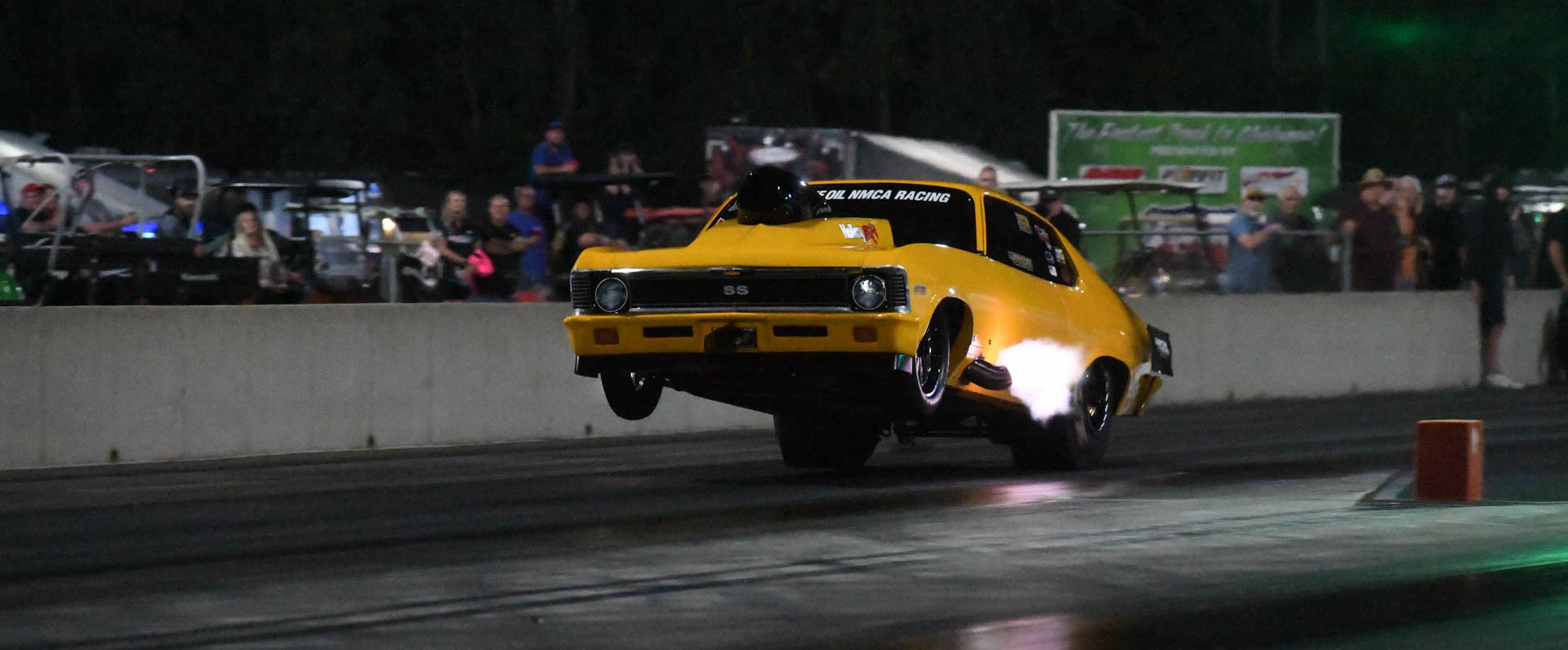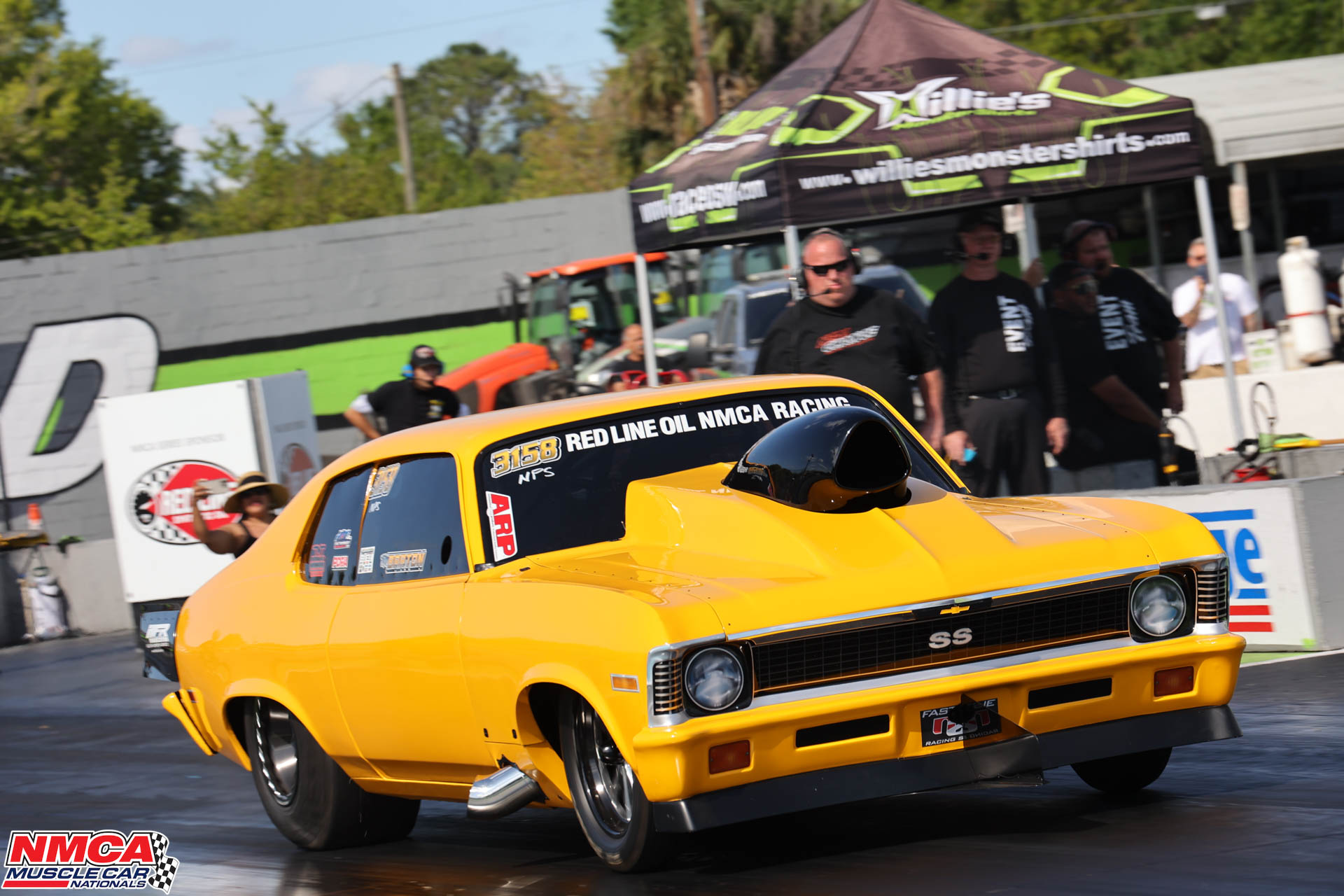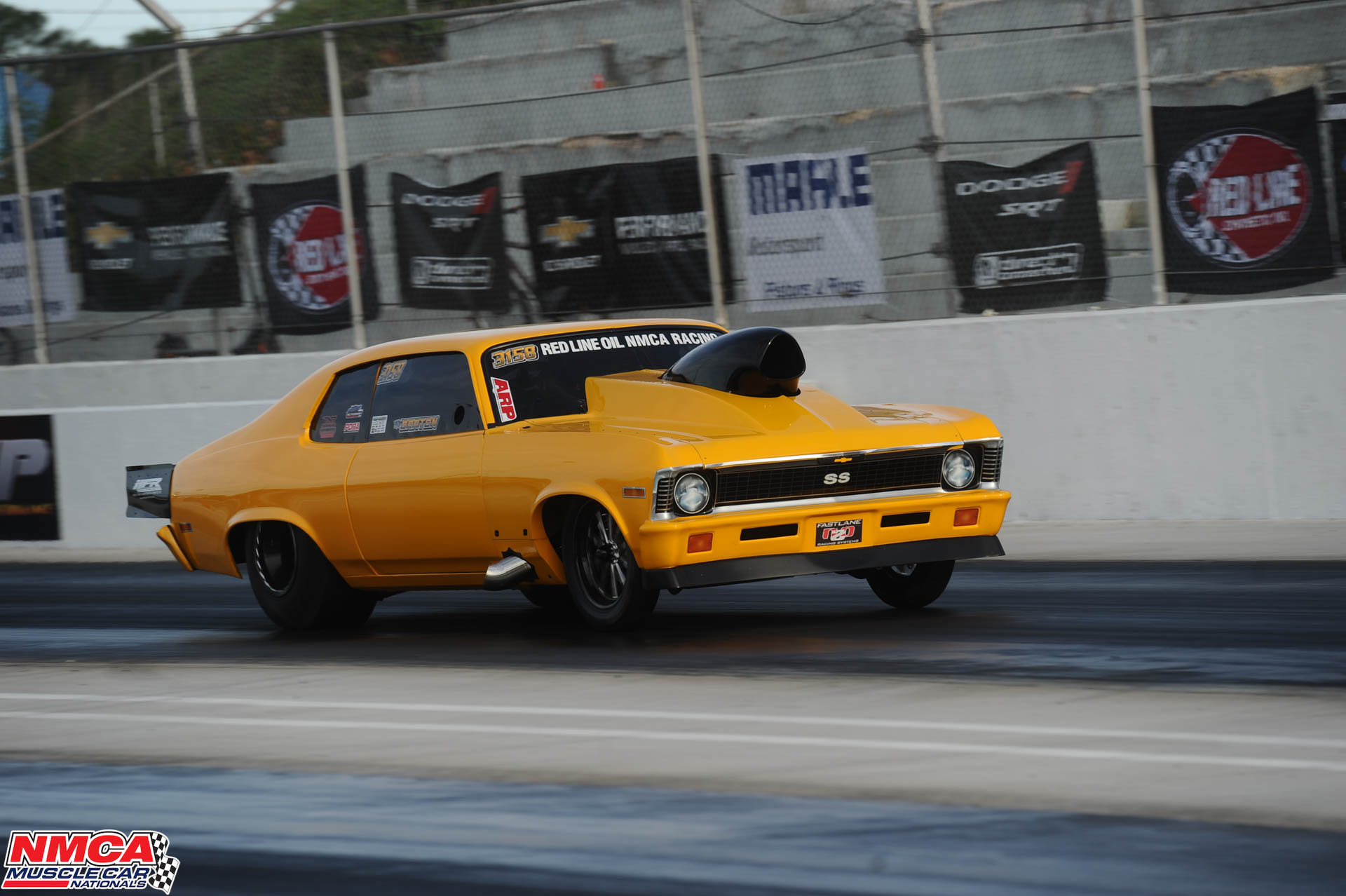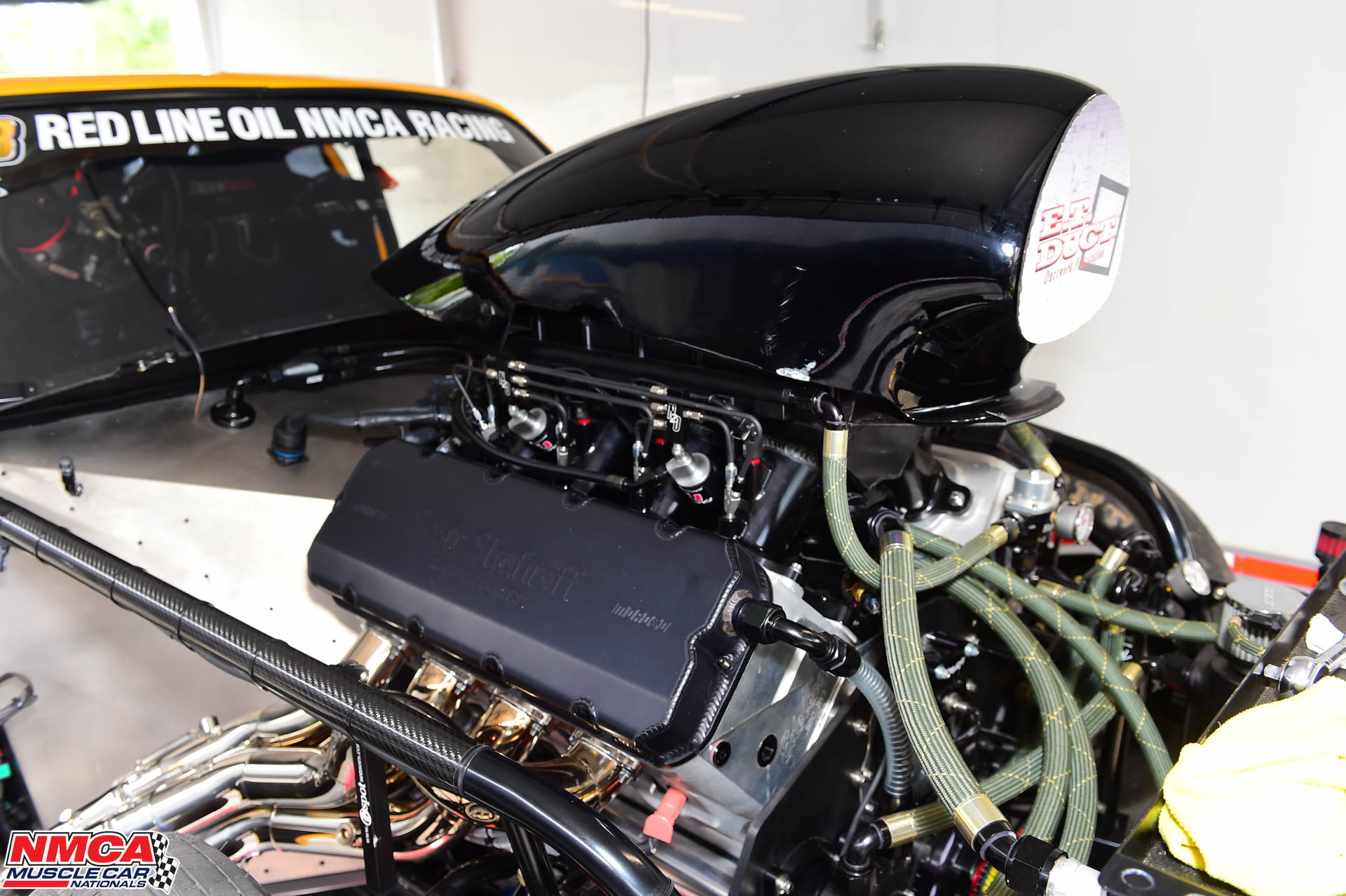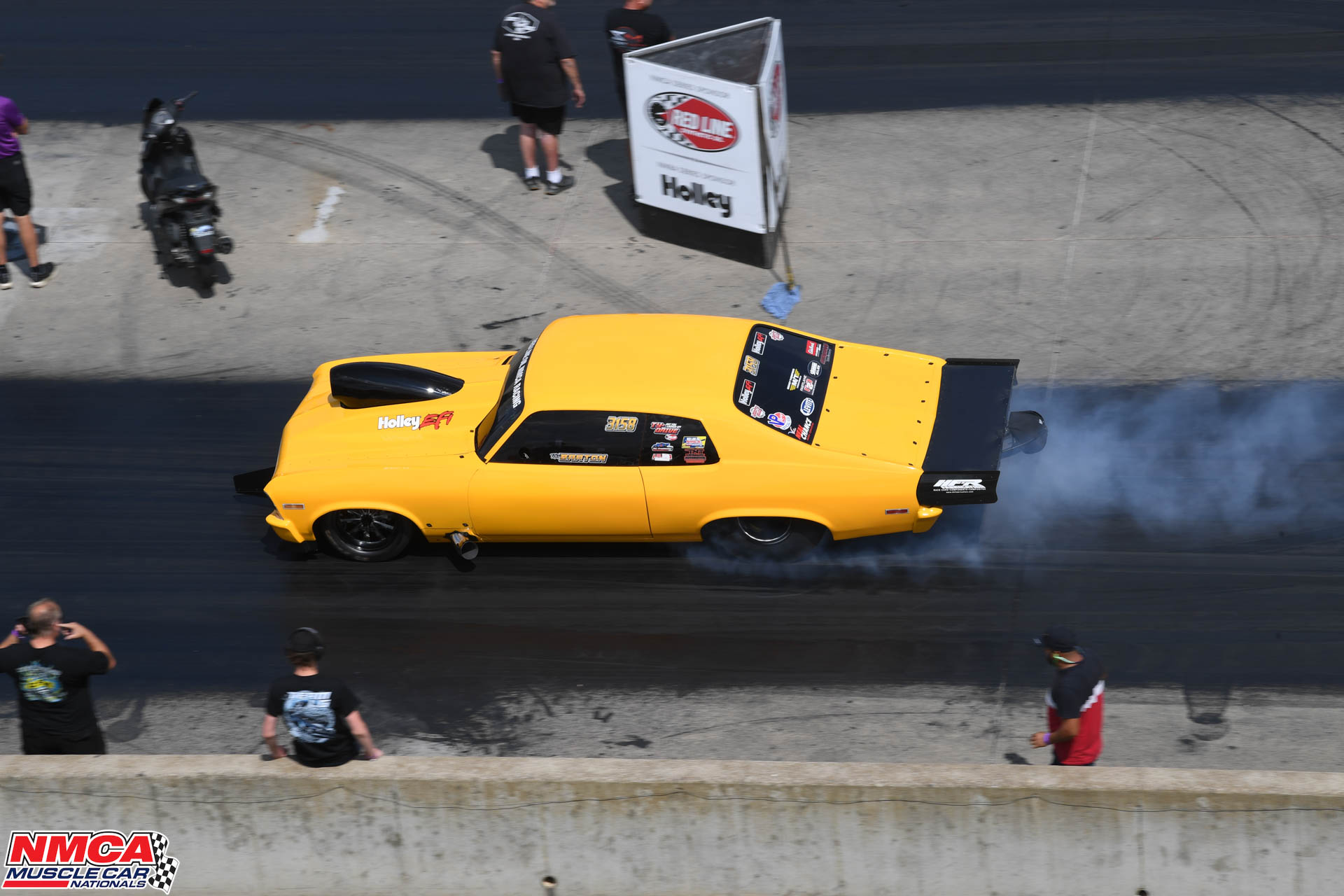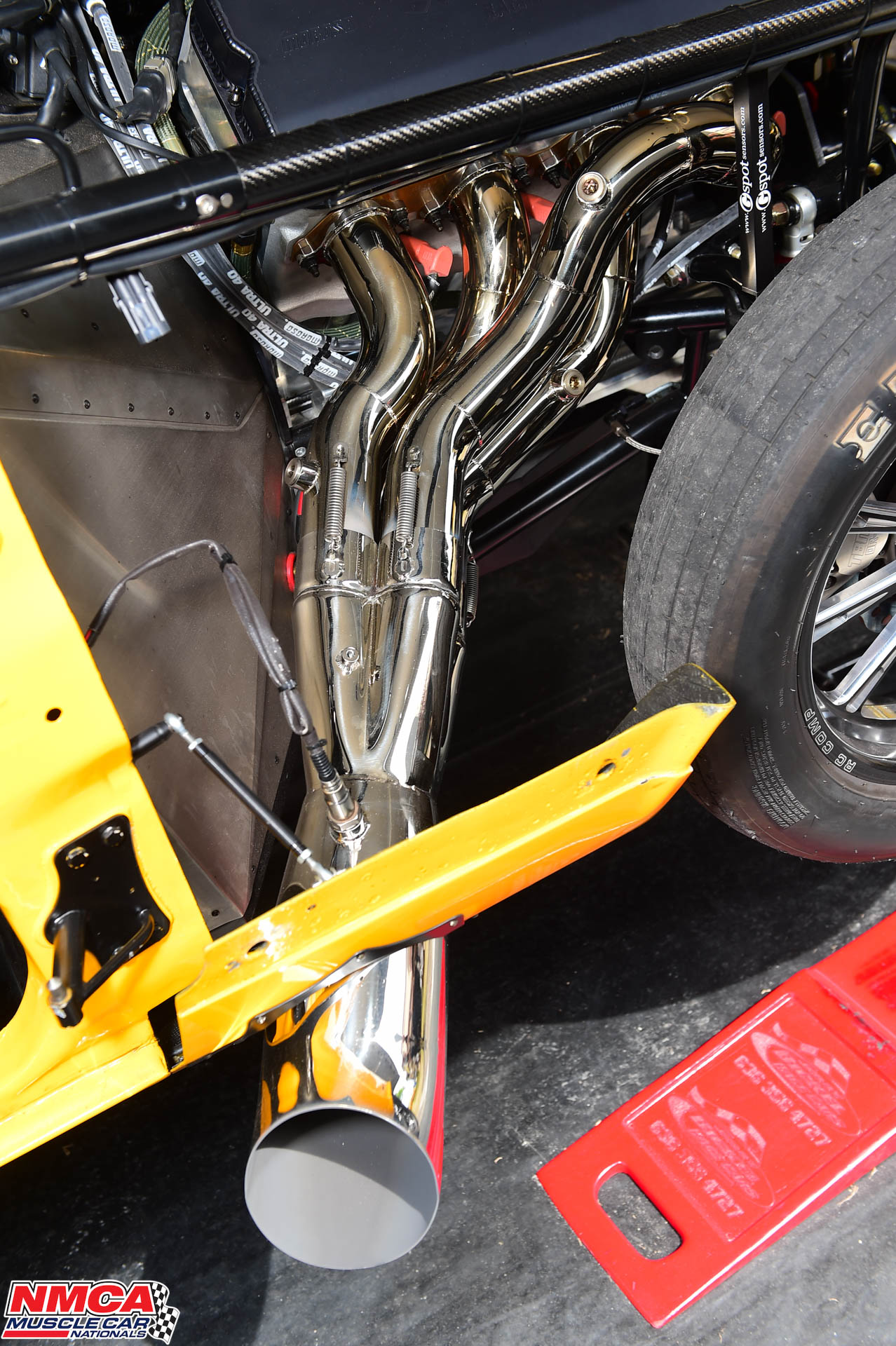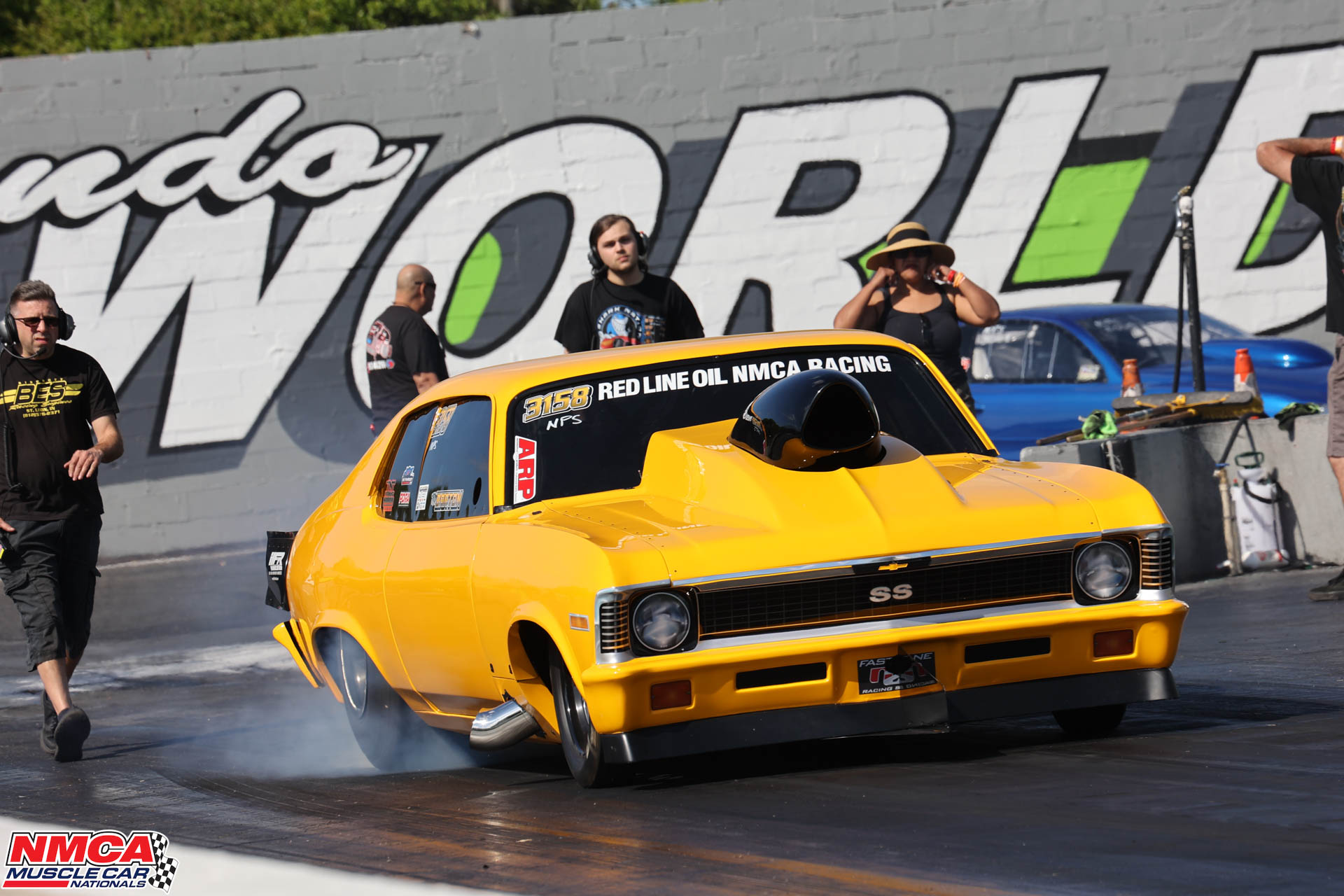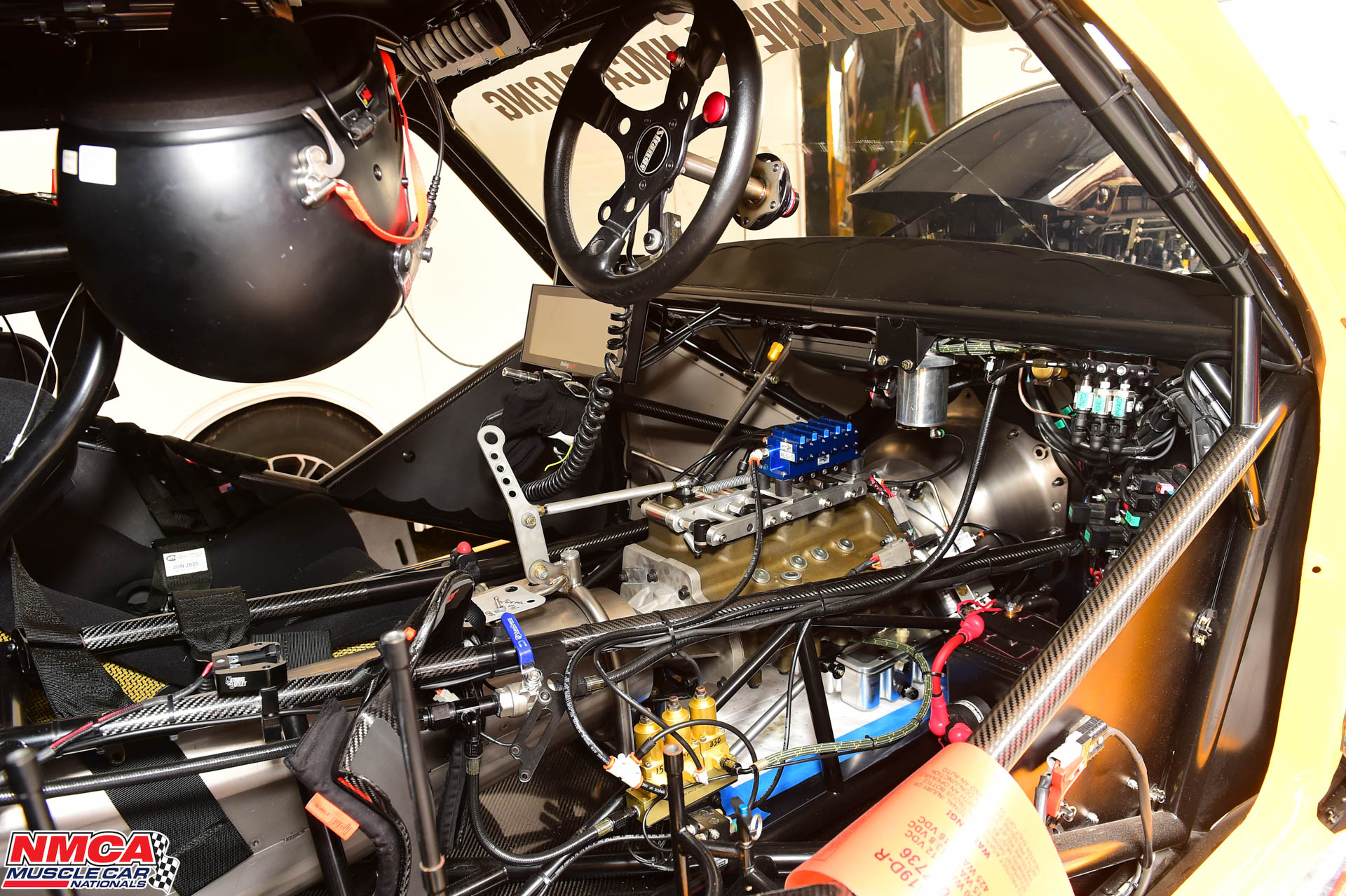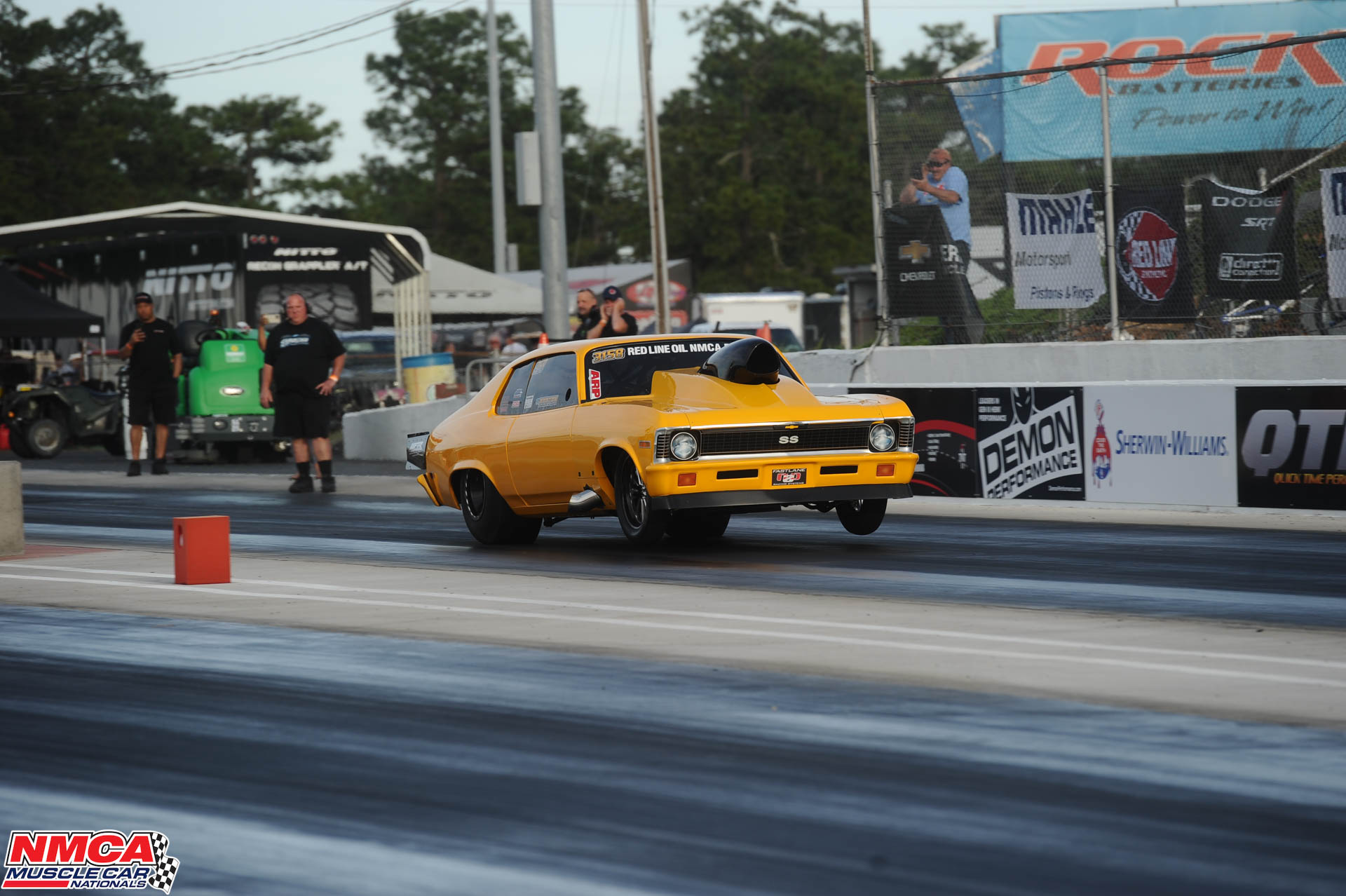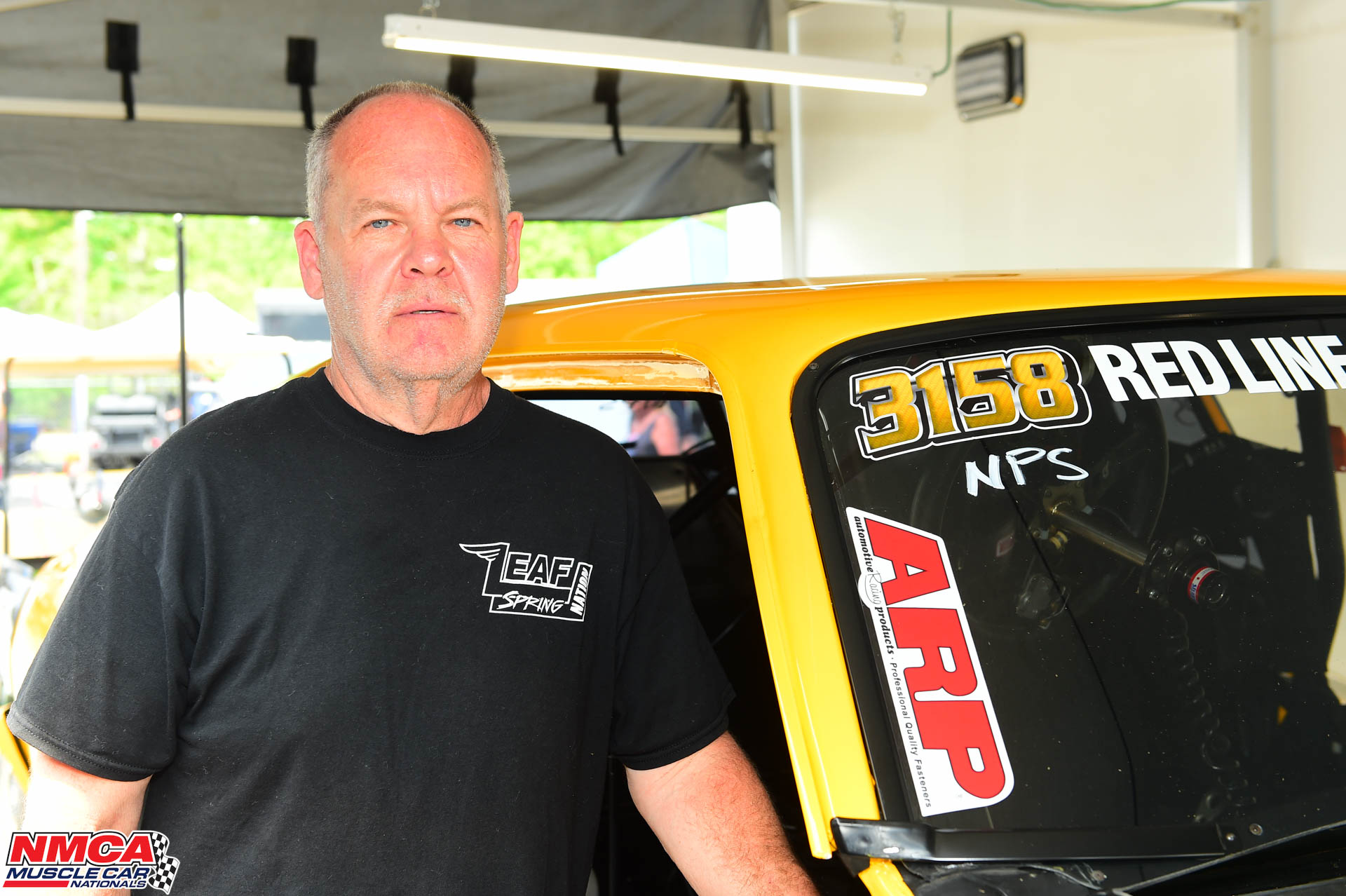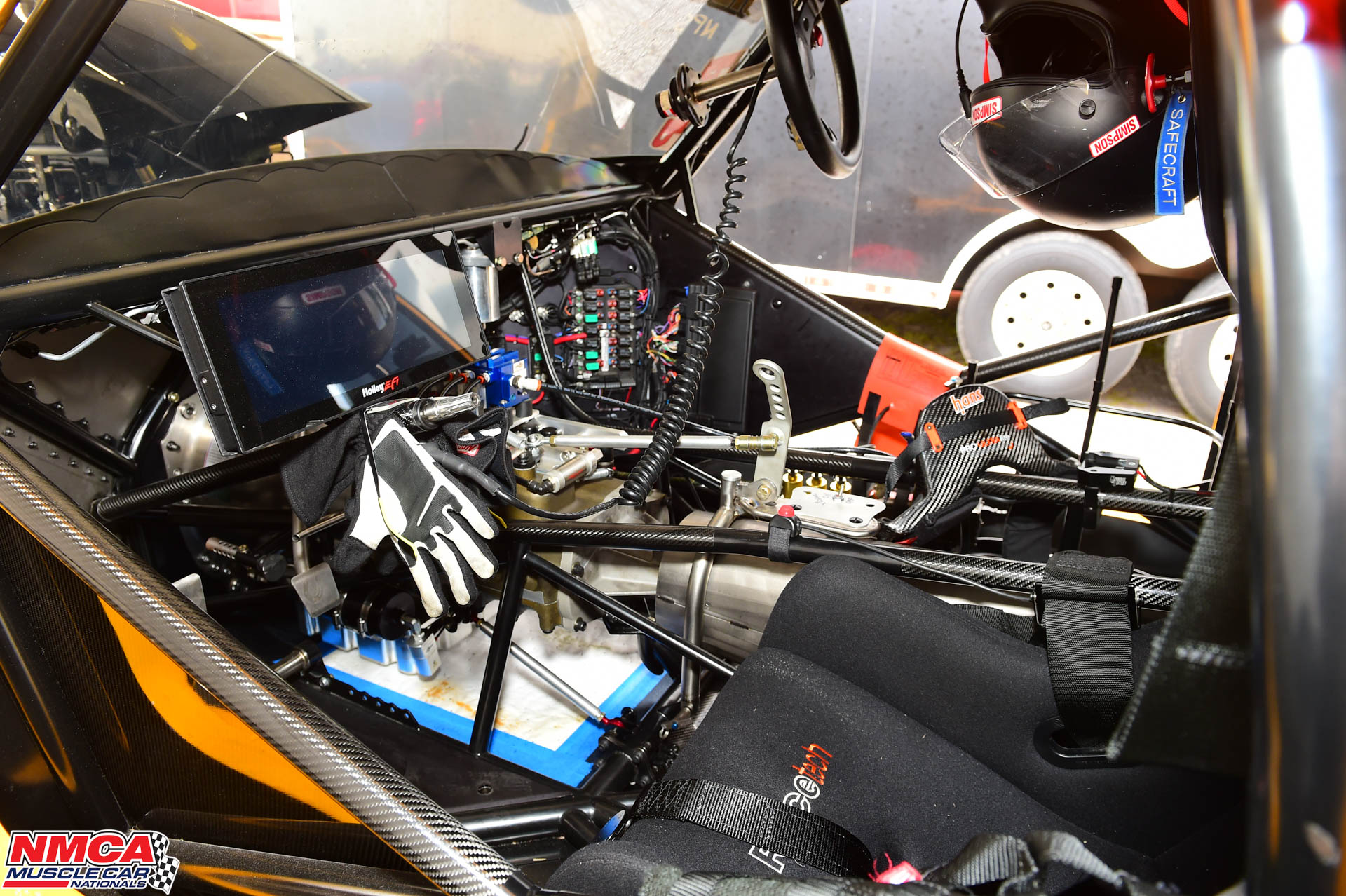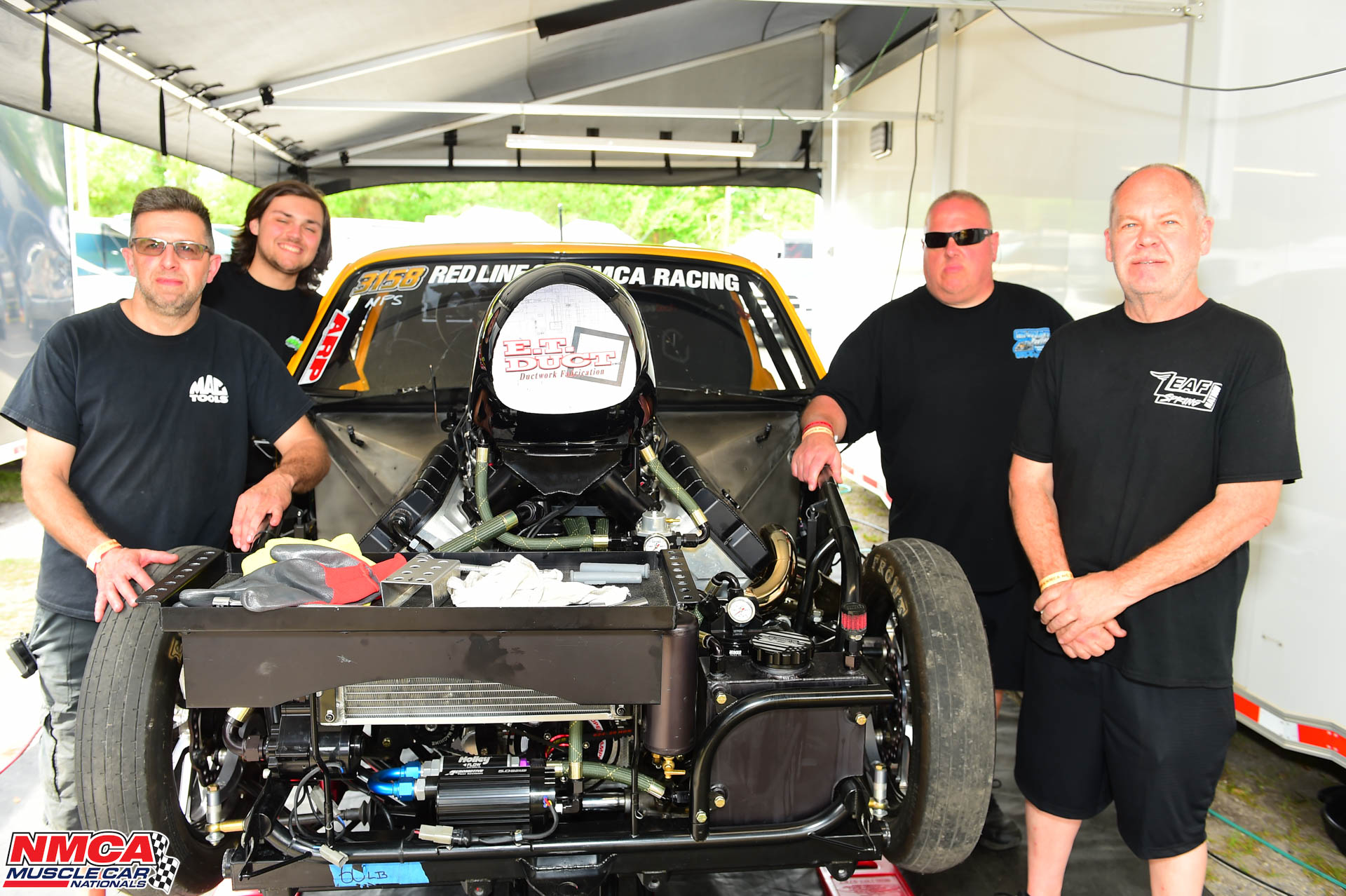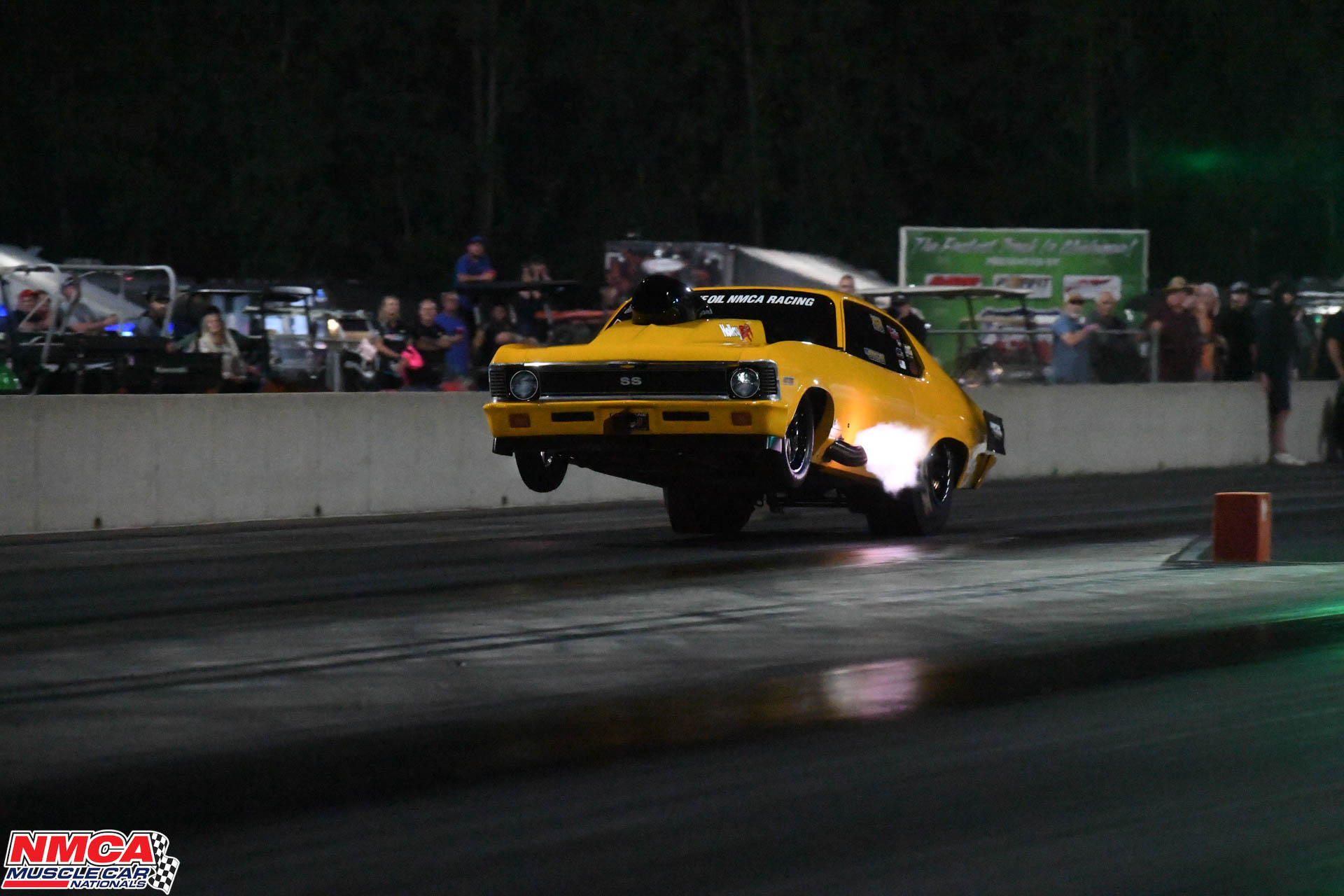Leaf Goer—Tim Barton’s ARP Nitrous Pro Street Chevy Nova is a leaf-spring speed machine
Written by Ainsley Jacobs
Photography by the FSC staff
Sitting serenely in the pits before it goes out to blast down the track in NMCA’s ARP Nitrous Pro Street category, Timothy Barton’s 1973 Chevrolet Nova looks much like any other big-tire doorslammer running in the pro ranks but it holds a secret beneath its back half — old school leaf springs.
The Chevy’s owner, Tim Barton, grew up on Long Island racing on the streets. He and his Suffolk County neighborhood friends had always had an interest in fast cars, and Barton owned a 1972 Nova with a big-block engine under its hood and a Ford 9-inch rearend. “It was set up to run on the streets and yeah, I got a win or two over the years, of course,” said Barton, who was one of the lucky ones never to have his license taken away as a result of his less-than-legal activities throughout the mid-1980s.
Barton was no stranger to parts breakages as he hunted for higher horsepower and he learned how to wrench as a result. Supplementing his street racing with on-track testing, Barton would occasionally head out to Tri-State area drag strips such as New Jersey’s legendary Old Bridge Township Raceway Park in Englishtown and nearby Atco Dragway, as well as Lebanon Valley Dragway in upstate New York.
When he graduated from high school in 1982, Barton, now 59 years old, took a job in the sheetmetal industry. After a few years spent gathering knowledge, skill, and experience, in 1989 he opened his company, E T Duct Systems, where he specialized in sheetmetal fabrication for HVAC ductwork systems.
A lifelong Chevy guy who always had an appreciation for the Nova’s bodylines, style, and overall brand in general, Barton always knew he wanted to get into racing at a higher level. So, when the time was right, there was no other car he wanted to choose.
In 2018, Barton was browsing around online and found a listing that piqued his interest: a 1973 Nova in California was for sale from an older gentleman and he couldn’t resist temptation. “I flew out to take a look and went over everything. It was a clear car that was well put together,” recalled Barton, whose intention at first was to go bracket racing with the Nova at Island Dragway in New Jersey. “I bought it and had it shipped back to New York.”
After two years, Barton had decided to move into radial racing and knew the Nova required a complete rebuild as a result. “I knew Henry Fryfogle builds a lot of radial cars and he has done many high-end, successful cars and knows his stuff, so I brought the car to him in 2020,” Barton explained of the overall which took roughly eight months at HFR Fabrication in Maryland.
Fryfogle completely redid the chassis “from front to back” and fabricated the 25.2 SFI-certified roll cage. After Barton received the revamped ride, he had his friend, Brian Khun, complete the wiring job needed to power the engine and electronic components.
Barton enlisted local Long Island engine builder, Scott Shafiroff Race Engines, to put together the 638-cubic-inch big-block Chevrolet powerplant. SSRE’s engine builder, Jack Boer, was the key man on the project and expertly assembled the CN engine block and Edelbrock Pro Port BV3 cylinder heads. He also incorporated a world-class Winberg crankshaft, GRP connecting rods, Gibtec pistons, and a Bullet camshaft, and the powerplant produced 1,260 horsepower on the engine dyno in a naturally aspirated configuration.
For a power adder, Barton knew it was nitrous or nothing and two kits from Robert Lane’s Fast Lane Nitrous Racing Systems were installed. “My tuner, Mike Thompson from TNT Performance Automotive in Oswego, knows and prefers nitrous, and I’ve always dabbled with it ever since my street racing days,” he clarified of the conscious choice not to use a supercharged or turbocharged setup instead.
As Barton’s Nova came to him with a carburetor, he used 2020’s rebuild period as an opportunity to switch to a more modern electronic fuel injection system instead. The EFI would give Thompson more control with tuning and give both men more options when it came to dialing in the entire combination. “We’re running a Holley Dominator EFI system and everything else is Holley as well including the injectors and fuel system,” noted Barton.
Despite the new-school technology utilized throughout the build, Barton intentionally chose to keep the Nova’s rear suspension firmly planted in its old-school roots with leaf springs. “People are so shocked because it sits so low, they always think it’s a four-link car,” laughed Barton, who loves surprising fans and onlookers by telling them to get underneath the Nova and see for themselves. “It’s not something you usually see – it’s pretty unconventional for racing at this level.”
With a set of Calvert Racing CalTrac traction bars incorporated, Fryfogle also made some major modifications to the rear in order for the Nova to be able to run properly with its vintage equipment. “I chose to stick with the leaf springs because they’re original to the car, and because it works,” shared the driver who maintains a purist mentality. “It’s proven and it works. It goes to show, you don’t always need a four-link.”
Also under the latter half of the Nova, a Ford 9-inch rearend can be found along with a Strange Engineering center section, a Strange gearset, Mark Williams Enterprises axles, and a Precision Shaft Technologies carbon fiber driveshaft.
“The only thing that still exists from the original purchase is the Nova’s body and rearend,” added Barton, who upgraded the Chevy’s front end with a complete tubular replacement from Smith Racecraft and Santhuff shocks at all four corners. It was that body, bathed in bright yellow paint, that initially caught Barton’s eye. “I liked the color so much that I didn’t want to change it. It stands out and looks good. It just works.”
At first, Barton raced in Maryland with the Warriors Outlaw Drag Race group. In 2021, he ran a personal best of 4.10 seconds at 175 mph in the eighth-mile while on drag radial tires at Maryland International Raceway with an impressive 0.999-second 60-foot time, but, eventually, “things got too complicated with them” and he decided to go a different route instead… NMCA Nitrous Pro Street.
To prepare, during the 2021-2022 off-season, Barton swapped out his Turbo 400 automatic in favor of a Liberty five-speed manual with a Ty-Drive converter drive and a Neal Chance torque converter. “The Liberty gives us more options, too, since we can do a three-speed or a five-speed,” said Barton, who enjoys being more involved in the driving process as opposed to wheeling with a more traditional transmission.
It was in 2022 that he made his big debut in NMCA ARP Nitrous Pro Street and his first race with the series was at the famed Summit Motorsports Park in Norwalk, Ohio, in August. At the NMCA All-American Nationals, Barton qualified eighth overall with a best blast of 4.498 at 159.91 mph. Although he didn’t make headway in eliminations, he still proved that his HFR-built 1973 Nova was a powerful player with plenty of potential.
The following month, Barton made the trip to historic Lucas Oil Indianapolis Raceway Park in Indiana for the NMCA World Street Finals. There, he qualified fourth in a competitive field with a quickest run of 4.324 at 164.63 mph and went on to get a first-round win in eliminations over Bill Garrock before Billy Glidden dispatched Barton back to the trailer in round two.
“We had a couple of good runs that season and were still on the radials. We shouldn’t have been, but were trying it out to see how everything worked,” noted Barton, who finished eighth overall in NMCA ARP Nitrous Pro Street Points for the 2022 season.
During the coming winter months, Barton and his boys spent their time rebuilding engines and putting together a spare that he would be able to depend on in case of any unforeseen problems. Other than freshening up the standard components and stockpiling lots of pistons and parts, no major changes were made.
In 2023, Barton began his first full season of Nitrous Pro Street racing with the Red Line Oil NMCA Muscle Car Nationals series.
Starting out at the NMCA Spring Break Shootout season opener at Florida’s Orlando Speed World Dragway in March, Barton positioned himself near the top of the qualifying order in third with his run of 4.398 at 164.17 mph. In round one, a 4.462 at 166.25 mph pass enabled him to move on against Leonard Grawburg, but Barton spun unexpectedly in round two and had to coast across the finish line at a sub-par speed.
“The car was going OK but we were having problems with spinning the tires because we were running the radial again,” said Barton, dismayed that he was having equal parts success and failure.
The tricky traction troubles continued to plague him the following month at the NMRA/NMCA All-Star Nationals at North Carolina’s Rockingham Dragway, too. Despite qualifying second with a 4.325 at 176.47 mph timeslip in his hands, round one of eliminations once again saw Barton’s Nova idle through the traps after having spun its tires.
In St. Louis, Missouri, for the NMRA/NMCA Super Bowl of Muscle Car Drag Racing at World Wide Technology Raceway in May, Barton made progress on finally getting down the track. From qualifying fifth with a 4.401 at 166.39 mph trip to going 4.438 at 167.18 mph in the first elimination pairing, his celebration was short-lived as Kyle Salminen simply had the quicker car and ended Barton’s weekend before it had barely even started.
Originally, Barton’s classic Nova had been built to run on radials, not slick tires. After having had inconsistent success with the radials and doing everything he could to make them work in Nitrous Pro Street competition, he accepted that perhaps the slick would serve him better and made the change.
With the new rubber in place for the NMRA/NMCA Power Festival in July at US 131 Motorsports Park in Martin, Michigan, Barton finally “got it to go right.” Early testing threw a kink in his plans, though, as a hurt engine and a big nitrous backfire which blew the intake off cause some scrambling in his pit area, but Barton’s team got the Nova buttoned back up in a hurry.
Next, after having gone 4.372 at 165.56 mph in qualifying to begin eliminations from the number eight spot, he got the first-round win without any additional issues. “Unfortunately, I was going up against Lenny [Grawburg] who I knew had a faster car and was putting out good numbers, so I was trying to tree him and left a little early,” Barton lamented. His 4.334 at 168.04 mph run would have made for a tight race against Grawburg’s 4.329 at 166.91 mph pass if not for the -0.069-second reaction time that tripped the red light for Barton.
“I’ve enjoyed running with the NMCA so far,” affirmed the man. “Everything is very well organized and professional and it works for us. Yes, it’s far to travel to some of these events, but it’s worth it because the series races at good tracks and we’re trying to get a handle on the car.”
Although he hasn’t been able to eclipse his prior personal best — which was set on 315 radials — with the slick tire setup, Barton does believe the crinkle-walls are the better choice overall for his current class and is confident that he’s heading in the right direction. “It’s just a matter of tuning it right, getting the transmission right, and getting the rear gear right,” he asserted.
Always one to be prepared, Barton has already sent his transmission back to Liberty to change the gearing and is changing both the gears in his rearend as well as switching to a new Neal Chance converter with a different stall speed. “And, we’re rebuilding the other motor to take with us to Ohio [for the NMCA All-American Nationals],” he continued.
Barton keeps a pretty small crew of his trusted people, including Fryfogle, Thompson, Boer, and Khun. He’s made friends in the NMCA ARP Nitrous Pro Street class, of course, and has a goal of catching frontrunner David Fallon. That mission, coupled with his love of letting his lifelong dream car, his leaf spring-equipped 1973 Nova, run flat-out while spraying plenty of nitrous into its engine, is what keeps him coming back for pass after pass – and what keeps him focused on the future, including the upcoming 2024 NMCA season.
The Details
Owner/Driver
Owner: Timothy Barton
Driver: Timothy Barton
Hometown: Bohemia, New York
Occupation: HVAC
Class: NMCA ARP Nitrous Pro Street
Crew: Brian and Jack
Car Year/Make/Model: 1973 Chevy Nova
Powertrain
Engine: Chevy
Engine builder: Shafiroff
Displacement: 638 cubic inches
Block: CN
Bore: 4.600 inches
Stroke: 4.800 inches
Crank: Winberg
Rods: GRP
Pistons: Gibtec
Heads: Edelbrock-Slawko
Valvetrain: T-D
Cam type: Bullet
Carburetor or EFI system: EFI Holley – TNT Perf. Auto
Power-adder: Fast Lane Nitrous
Fuel brand and type: VP Racing Fuels C25
Headers and exhaust: H.F.R.
Transmission: Liberty -TY Drive
Transmission Builder: Liberty Craig
Clutch/shifter/torque converter: Neal Chance
Rearend: H.F.R.
Chassis
Body and/or chassis builder: Nova 1973 H.F.R.
Suspension (Front): Ron Galbreath Afterwork’s
Suspension (Rear): Ron Galbreath Afterwork’s
Brakes (Front): TBM
Brakes (Rear):
Wheels (front): RC
Wheels (Rear): M/T
Tires (Front):
Tires (Rear):
Aftermarket body modifications: Glasster
Safety Equipment: White
Vehicle weight: 2,800 pounds
Quickest ET: 4.30 seconds
Best 60-foot: 105 seconds
Fastest mph: 168
Sponsors: ET Duct, Shafirott Racing
Written by Ainsley Jacobs
Photography by the FSC staff
Sitting serenely in the pits before it goes out to blast down the track in NMCA’s ARP Nitrous Pro Street category, Timothy Barton’s 1973 Chevrolet Nova looks much like any other big-tire doorslammer running in the pro ranks but it holds a secret beneath its back half — old school leaf springs.
The Chevy’s owner, Tim Barton, grew up on Long Island racing on the streets. He and his Suffolk County neighborhood friends had always had an interest in fast cars, and Barton owned a 1972 Nova with a big-block engine under its hood and a Ford 9-inch rearend. “It was set up to run on the streets and yeah, I got a win or two over the years, of course,” said Barton, who was one of the lucky ones never to have his license taken away as a result of his less-than-legal activities throughout the mid-1980s.
Barton was no stranger to parts breakages as he hunted for higher horsepower and he learned how to wrench as a result. Supplementing his street racing with on-track testing, Barton would occasionally head out to Tri-State area drag strips such as New Jersey’s legendary Old Bridge Township Raceway Park in Englishtown and nearby Atco Dragway, as well as Lebanon Valley Dragway in upstate New York.
When he graduated from high school in 1982, Barton, now 59 years old, took a job in the sheetmetal industry. After a few years spent gathering knowledge, skill, and experience, in 1989 he opened his company, E T Duct Systems, where he specialized in sheetmetal fabrication for HVAC ductwork systems.
A lifelong Chevy guy who always had an appreciation for the Nova’s bodylines, style, and overall brand in general, Barton always knew he wanted to get into racing at a higher level. So, when the time was right, there was no other car he wanted to choose.
In 2018, Barton was browsing around online and found a listing that piqued his interest: a 1973 Nova in California was for sale from an older gentleman and he couldn’t resist temptation. “I flew out to take a look and went over everything. It was a clear car that was well put together,” recalled Barton, whose intention at first was to go bracket racing with the Nova at Island Dragway in New Jersey. “I bought it and had it shipped back to New York.”
After two years, Barton had decided to move into radial racing and knew the Nova required a complete rebuild as a result. “I knew Henry Fryfogle builds a lot of radial cars and he has done many high-end, successful cars and knows his stuff, so I brought the car to him in 2020,” Barton explained of the overall which took roughly eight months at HFR Fabrication in Maryland.
Fryfogle completely redid the chassis “from front to back” and fabricated the 25.2 SFI-certified roll cage. After Barton received the revamped ride, he had his friend, Brian Khun, complete the wiring job needed to power the engine and electronic components.
Barton enlisted local Long Island engine builder, Scott Shafiroff Race Engines, to put together the 638-cubic-inch big-block Chevrolet powerplant. SSRE’s engine builder, Jack Boer, was the key man on the project and expertly assembled the CN engine block and Edelbrock Pro Port BV3 cylinder heads. He also incorporated a world-class Winberg crankshaft, GRP connecting rods, Gibtec pistons, and a Bullet camshaft, and the powerplant produced 1,260 horsepower on the engine dyno in a naturally aspirated configuration.
For a power adder, Barton knew it was nitrous or nothing and two kits from Robert Lane’s Fast Lane Nitrous Racing Systems were installed. “My tuner, Mike Thompson from TNT Performance Automotive in Oswego, knows and prefers nitrous, and I’ve always dabbled with it ever since my street racing days,” he clarified of the conscious choice not to use a supercharged or turbocharged setup instead.
As Barton’s Nova came to him with a carburetor, he used 2020’s rebuild period as an opportunity to switch to a more modern electronic fuel injection system instead. The EFI would give Thompson more control with tuning and give both men more options when it came to dialing in the entire combination. “We’re running a Holley Dominator EFI system and everything else is Holley as well including the injectors and fuel system,” noted Barton.
Despite the new-school technology utilized throughout the build, Barton intentionally chose to keep the Nova’s rear suspension firmly planted in its old-school roots with leaf springs. “People are so shocked because it sits so low, they always think it’s a four-link car,” laughed Barton, who loves surprising fans and onlookers by telling them to get underneath the Nova and see for themselves. “It’s not something you usually see – it’s pretty unconventional for racing at this level.”
With a set of Calvert Racing CalTrac traction bars incorporated, Fryfogle also made some major modifications to the rear in order for the Nova to be able to run properly with its vintage equipment. “I chose to stick with the leaf springs because they’re original to the car, and because it works,” shared the driver who maintains a purist mentality. “It’s proven and it works. It goes to show, you don’t always need a four-link.”
Also under the latter half of the Nova, a Ford 9-inch rearend can be found along with a Strange Engineering center section, a Strange gearset, Mark Williams Enterprises axles, and a Precision Shaft Technologies carbon fiber driveshaft.
“The only thing that still exists from the original purchase is the Nova’s body and rearend,” added Barton, who upgraded the Chevy’s front end with a complete tubular replacement from Smith Racecraft and Santhuff shocks at all four corners. It was that body, bathed in bright yellow paint, that initially caught Barton’s eye. “I liked the color so much that I didn’t want to change it. It stands out and looks good. It just works.”
At first, Barton raced in Maryland with the Warriors Outlaw Drag Race group. In 2021, he ran a personal best of 4.10 seconds at 175 mph in the eighth-mile while on drag radial tires at Maryland International Raceway with an impressive 0.999-second 60-foot time, but, eventually, “things got too complicated with them” and he decided to go a different route instead… NMCA Nitrous Pro Street.
To prepare, during the 2021-2022 off-season, Barton swapped out his Turbo 400 automatic in favor of a Liberty five-speed manual with a Ty-Drive converter drive and a Neal Chance torque converter. “The Liberty gives us more options, too, since we can do a three-speed or a five-speed,” said Barton, who enjoys being more involved in the driving process as opposed to wheeling with a more traditional transmission.
It was in 2022 that he made his big debut in NMCA ARP Nitrous Pro Street and his first race with the series was at the famed Summit Motorsports Park in Norwalk, Ohio, in August. At the NMCA All-American Nationals, Barton qualified eighth overall with a best blast of 4.498 at 159.91 mph. Although he didn’t make headway in eliminations, he still proved that his HFR-built 1973 Nova was a powerful player with plenty of potential.
The following month, Barton made the trip to historic Lucas Oil Indianapolis Raceway Park in Indiana for the NMCA World Street Finals. There, he qualified fourth in a competitive field with a quickest run of 4.324 at 164.63 mph and went on to get a first-round win in eliminations over Bill Garrock before Billy Glidden dispatched Barton back to the trailer in round two.
“We had a couple of good runs that season and were still on the radials. We shouldn’t have been, but were trying it out to see how everything worked,” noted Barton, who finished eighth overall in NMCA ARP Nitrous Pro Street Points for the 2022 season.
During the coming winter months, Barton and his boys spent their time rebuilding engines and putting together a spare that he would be able to depend on in case of any unforeseen problems. Other than freshening up the standard components and stockpiling lots of pistons and parts, no major changes were made.
In 2023, Barton began his first full season of Nitrous Pro Street racing with the Red Line Oil NMCA Muscle Car Nationals series.
Starting out at the NMCA Spring Break Shootout season opener at Florida’s Orlando Speed World Dragway in March, Barton positioned himself near the top of the qualifying order in third with his run of 4.398 at 164.17 mph. In round one, a 4.462 at 166.25 mph pass enabled him to move on against Leonard Grawburg, but Barton spun unexpectedly in round two and had to coast across the finish line at a sub-par speed.
“The car was going OK but we were having problems with spinning the tires because we were running the radial again,” said Barton, dismayed that he was having equal parts success and failure.
The tricky traction troubles continued to plague him the following month at the NMRA/NMCA All-Star Nationals at North Carolina’s Rockingham Dragway, too. Despite qualifying second with a 4.325 at 176.47 mph timeslip in his hands, round one of eliminations once again saw Barton’s Nova idle through the traps after having spun its tires.
In St. Louis, Missouri, for the NMRA/NMCA Super Bowl of Muscle Car Drag Racing at World Wide Technology Raceway in May, Barton made progress on finally getting down the track. From qualifying fifth with a 4.401 at 166.39 mph trip to going 4.438 at 167.18 mph in the first elimination pairing, his celebration was short-lived as Kyle Salminen simply had the quicker car and ended Barton’s weekend before it had barely even started.
Originally, Barton’s classic Nova had been built to run on radials, not slick tires. After having had inconsistent success with the radials and doing everything he could to make them work in Nitrous Pro Street competition, he accepted that perhaps the slick would serve him better and made the change.
With the new rubber in place for the NMRA/NMCA Power Festival in July at US 131 Motorsports Park in Martin, Michigan, Barton finally “got it to go right.” Early testing threw a kink in his plans, though, as a hurt engine and a big nitrous backfire which blew the intake off cause some scrambling in his pit area, but Barton’s team got the Nova buttoned back up in a hurry.
Next, after having gone 4.372 at 165.56 mph in qualifying to begin eliminations from the number eight spot, he got the first-round win without any additional issues. “Unfortunately, I was going up against Lenny [Grawburg] who I knew had a faster car and was putting out good numbers, so I was trying to tree him and left a little early,” Barton lamented. His 4.334 at 168.04 mph run would have made for a tight race against Grawburg’s 4.329 at 166.91 mph pass if not for the -0.069-second reaction time that tripped the red light for Barton.
“I’ve enjoyed running with the NMCA so far,” affirmed the man. “Everything is very well organized and professional and it works for us. Yes, it’s far to travel to some of these events, but it’s worth it because the series races at good tracks and we’re trying to get a handle on the car.”
Although he hasn’t been able to eclipse his prior personal best — which was set on 315 radials — with the slick tire setup, Barton does believe the crinkle-walls are the better choice overall for his current class and is confident that he’s heading in the right direction. “It’s just a matter of tuning it right, getting the transmission right, and getting the rear gear right,” he asserted.
Always one to be prepared, Barton has already sent his transmission back to Liberty to change the gearing and is changing both the gears in his rearend as well as switching to a new Neal Chance converter with a different stall speed. “And, we’re rebuilding the other motor to take with us to Ohio [for the NMCA All-American Nationals],” he continued.
Barton keeps a pretty small crew of his trusted people, including Fryfogle, Thompson, Boer, and Khun. He’s made friends in the NMCA ARP Nitrous Pro Street class, of course, and has a goal of catching frontrunner David Fallon. That mission, coupled with his love of letting his lifelong dream car, his leaf spring-equipped 1973 Nova, run flat-out while spraying plenty of nitrous into its engine, is what keeps him coming back for pass after pass – and what keeps him focused on the future, including the upcoming 2024 NMCA season.
The Details
Owner/Driver
Owner: Timothy Barton
Driver: Timothy Barton
Hometown: Bohemia, New York
Occupation: HVAC
Class: NMCA ARP Nitrous Pro Street
Crew: Brian and Jack
Car Year/Make/Model: 1973 Chevy Nova
Powertrain
Engine: Chevy
Engine builder: Shafiroff
Displacement: 638 cubic inches
Block: CN
Bore: 4.600 inches
Stroke: 4.800 inches
Crank: Winberg
Rods: GRP
Pistons: Gibtec
Heads: Edelbrock-Slawko
Valvetrain: T-D
Cam type: Bullet
Carburetor or EFI system: EFI Holley – TNT Perf. Auto
Power-adder: Fast Lane Nitrous
Fuel brand and type: VP Racing Fuels C25
Headers and exhaust: H.F.R.
Transmission: Liberty -TY Drive
Transmission Builder: Liberty Craig
Clutch/shifter/torque converter: Neal Chance
Rearend: H.F.R.
Chassis
Body and/or chassis builder: Nova 1973 H.F.R.
Suspension (Front): Ron Galbreath Afterwork’s
Suspension (Rear): Ron Galbreath Afterwork’s
Brakes (Front): TBM
Brakes (Rear):
Wheels (front): RC
Wheels (Rear): M/T
Tires (Front):
Tires (Rear):
Aftermarket body modifications: Glasster
Safety Equipment: White
Vehicle weight: 2,800 pounds
Quickest ET: 4.30 seconds
Best 60-foot: 105 seconds
Fastest mph: 168
Sponsors: ET Duct, Shafirott Racing



